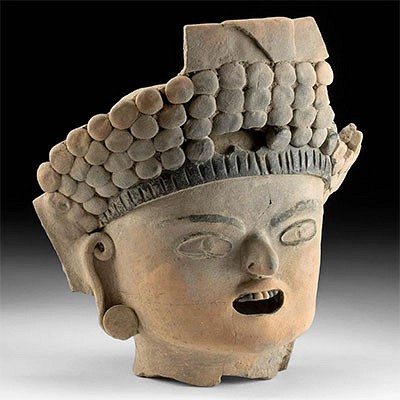17th C. Nepalese Stone Stele of Bodhisattva, Manjushri
Lot 101a
About Seller
Artemis Fine Arts
686 S Taylor Ave, Ste 106
Louisville, CO 80027
United States
Selling antiquities, ancient and ethnographic art online since 1993, Artemis Gallery specializes in Classical Antiquities (Egyptian, Greek, Roman, Near Eastern), Asian, Pre-Columbian, African / Tribal / Oceanographic art. Our extensive inventory includes pottery, stone, metal, wood, glass and textil...Read more
Categories
Estimate:
$3,600 - $5,400
Absentee vs Live bid
Two ways to bid:
- Leave a max absentee bid and the platform will bid on your behalf up to your maximum bid during the live auction.
- Bid live during the auction and your bids will be submitted real-time to the auctioneer.
Bid Increments
| Price | Bid Increment |
|---|---|
| $0 | $25 |
| $300 | $50 |
| $1,000 | $100 |
| $2,000 | $250 |
| $5,000 | $500 |
| $10,000 | $1,000 |
| $20,000 | $2,500 |
| $50,000 | $5,000 |
| $100,000 | $10,000 |
| $200,000 | $20,000 |
About Auction
By Artemis Fine Arts
May 18, 2023
Set Reminder
2023-05-18 10:00:00
2023-05-18 10:00:00
America/New_York
Bidsquare
Bidsquare : Ancient | Asian | Ethnographic Art
https://www.bidsquare.com/auctions/artemis-gallery/ancient-asian-ethnographic-art-12797
Featuring classical antiquities, ancient, and ethnographic art from cultures encompassing the globe. Egyptian, Greek, Roman, Near Eastern, Asian, Pre-Columbian, Native American, African / Tribal, Oceanic, Spanish Colonial, Fossils, more! All legally acquired, legal to sell. Satisfaction guaranteed. Artemis Fine Arts info@artemisgallery.com
Featuring classical antiquities, ancient, and ethnographic art from cultures encompassing the globe. Egyptian, Greek, Roman, Near Eastern, Asian, Pre-Columbian, Native American, African / Tribal, Oceanic, Spanish Colonial, Fossils, more! All legally acquired, legal to sell. Satisfaction guaranteed. Artemis Fine Arts info@artemisgallery.com
- Lot Description
Central Asia, Nepal, ca. 17th to 18th century CE. A fabulous stone stele depicting Manjushri, the bodhisattva of wisdom whose name means "Gentle Glory" in Sanskrit. Sitting in dhyanasana on a lotus base, Manjushri is shown traditionally with his 4 hands radiating around him and holding a sword, a scroll, a bow, and an arrow or lotus flower. His sword represents the realization of transcendent wisdom which cuts down ignorance and duality. An elaborate, floral headdress crowns his serene visage, which is comprised of arched brows over downcast eyes, a broad nose, full cheeks, and fleshy lips, while flowing robes drape his slender figure, and lavish earrings and beaded strands hang from his ears and neck. Traces of gold paint and red tika additionally adorn his face. A wonderful example of Buddhist iconography! Size: 9.5" W x 11" H (24.1 cm x 27.9 cm); 14" H (35.6 cm) on included custom stand.
Manjushri is known as a bodhisattva associated with transcendent wisdom (known as "prajna") in Mahayana Buddhism. Followers of Mahayana Buddhism believe that worshipping and following the teachings of Manjushri can confer upon them wisdom, increased memory, and heightened intelligence. In Tibetan / Vajrayana Buddhism, Manjushri is also known as a "Yidam," a physical manifestation of an enlightened mind or enlightenment. The name "Manjushri" translates as "Gentle Glory" in Sanskrit, and he is also known by his more-complete name - Manjushrikumarabhuta - which literally translated as "Manjushri, Still a Youth" or, less literally, "Prince Manjushri.
Provenance: private Loveland, Colorado, USA collection; ex-Tajan, France; ex-private Paris, France collection, 2016
All items legal to buy/sell under U.S. Statute covering cultural patrimony Code 2600, CHAPTER 14, and are guaranteed to be as described or your money back.
A Certificate of Authenticity will accompany all winning bids.
We ship worldwide and handle all shipping in-house for your convenience.
#177692Chipping with losses to sword, top periphery, crown, arrow or lotus flower, and left side of pedestal base. Nicks, chips, and abrasions to surface, all commensurate with age. Otherwise, excellent with nice remaining detail. Peg holes on verso with remains of wood and modern plastic likely from previous display.Condition
- Shipping Info
-
All shipping is handled in-house for your convenience. Your invoice from Artemis Gallery will include shipping calculation instructions. If in doubt, please inquire BEFORE bidding for estimated shipping costs for individual items.
-
- Buyer's Premium



 EUR
EUR CAD
CAD AUD
AUD GBP
GBP MXN
MXN HKD
HKD CNY
CNY MYR
MYR SEK
SEK SGD
SGD CHF
CHF THB
THB














